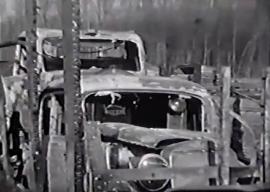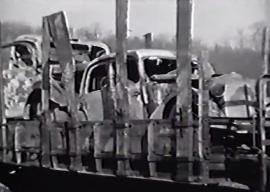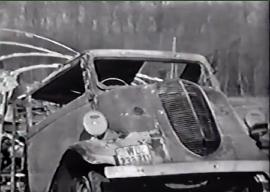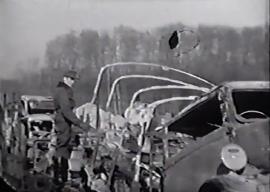Luftwaffenkommando West ordered that Hecht should be disbanded immediately. Its aircraft and any equipment they needed to stay operational were to be passed to 1.(F)/100.
On the evening of the 2nd, Sommer in Oranienburg was advised that landing (apparently in Biblis) would not be possible until the following afternoon but was later warned off until the 4th as the airfield was soft and very slippery.
Gen.d.A. noted that Kommando Sommer was transferring by rail to Osoppo for operations in Italy. This seems to be the earliest surviving use of that designation.
The 1.(F)/100’s evening report advised Lw.Kdo. West that Ar 234 WNr. 140344 was no longer on strength, having reverted to Versuchsverband OKL, but that a replacement aircraft was ready in Oranienburg. This is of interest because WNr. 140344 was Erich Sommer’s T9+EH and it seems that he had convinced his superiors to let him keep it and to send 1.(F)/100 another machine in its place. At 18.00 hrs. Biblis was told that the Versuchsverband must transfer to Kaltenkirchen immediately and that “for your transfer to Osoppo” (i.e. Sommer’s) use must primarily be made of “vehicles of other units.” The addressee was told to report to the Versuchsverband which vehicles could be sent straightaway to Oranienburg. It seems that there were insufficient lorries to manage the moves of both the Kommando and its parent unit and the issue was still "live" 10 days later.
The day’s Luftwaffe disposition map notes against Osoppo that Kdo. Sommer is being brought up. Reported aviation spirit stocks for Italy included 320 cubic metres (320,000 litres) of J2 jet fuel.
Kommando Sommer asked a Senior Signals Officer for an “exceptional authorisation” of Oblt. Loah to act as its representative.
The unit’s equipment had been loaded into rail wagons for transport to Italy but had barely got underway when American fighter-bombers attacked the train near Worms, destroying 80% of the Kommando’s materiel. Whatever could be salvaged was collected in the barracks at Biblis.
This air attack forced a rapid change of plan and it was ordered that Kdo. Götz be withdrawn from operations and its personnel and equipment (but not its aircraft) "prepare for transfer". This meant incidentally that 1.(F)/123 would have to get itself operational in the West unaided. Kommando Sommer’s personnel and what remained of its gear were to be absorbed back into the Versuchsverband OKL and was to remain in Biblis until further notice. On the morning of the 16th, Sommer was asked (apparently by 1.(F)/123) “if at all possible” to land “here” (Rheine?) after his next flight “to discuss the allocation of material between the new detachments.” Late in the day, Gen.d.A. signalled to Sommer that a previous order had been altered and that someone or something (only fragments of the text were intercepted) was to be withdrawn from operations: … and transferred into the sphere of command of GAFIT [German Airforce Italy] to Osoppo … Those Ar 234 at present on operations are to be given up to 1.(F)/123. The equipment necessary for the maintaining of operational readiness of 1.(F)/123 is to be given up to them by [word or words missing]. Replacement is to be applied for by … calling on Gen.d.A. … Despatch and arrival is to be reported to Gen.d.A.
The meaning of the above is clarified by an order from the Operations Officer of Lw.Kdo. West sent to 1.(F)/100 and to “1.(F)/123 for Kommando Götz”: (1) Carry out transfer of Kommando Götz ordered in Gen.d.A.’s No. 232. Send in request for transport at once. (2) Kommando Sommer will remain in Biblis at the disposal of Gen.d.A.
Kommando Goetz reported during the afternoon that it had completed handing over to 1.(F)/123 and would be departing “as a body” for Osoppo on 21 February. The Kommando asked also whether an advance party had arrived on the Italian airfield and how far and by whom it had been stocked up for the unit’s arrival. Erich Sommer was told (by whom is unclear) that, “Landing late in the afternoon possible. To what extent has stocking up for new [Kommando] been started?” Given the rather confused situation with the redeployment of Ar 234 units, one cannot be certain that this referred to Osoppo but it does seem likely.
A message had arrived the day before from “A/F DEF. OSOPPO” (an error for “A/F DET.” = airfield detachment, i.e. Platzkommando?) advised that two NCO’s and two other ranks had arrived there. But as the recipients noted the following morning, there was no runway [according to Sommer an extension was still being built] available and the length of the [grass] landing area had not yet been established but there was a Tornado direction-finding station. Nothing however was known about any preparations by higher authorities for the deployment of Ar 234s and the airfield had not been stocked up for them and Ltn. Gniesmer’s advanced party not yet arrived. The signal did however report that the landing area at Udine was 1600 metres in length. The remark about Osoppo’s “unavailable” runway is of interest because construction of a concrete one had begun there as long ago as December 1943 and it was 960 m long. That afternoon, Hptm. Goetz advised Sommer that Gniesmer (who had probably started from the Versuchsverband’s main base in Oranienburg, north of Berlin) had as yet got no further than Burg, landing there owing to a fault with his aircraft. Furthermore, Gen. d. A. had decided that in addition to the Kommandoführer, the 1. Staffel [of the Versuchsverband?] was to provide three pilots with experience in the West for the new Kommando Süd (i.e. South). The General had been asked [by Götz?] to detach Sommer with an aircraft to Kdo. Sperling and Sommer was asked to reply at once whether he agreed with that. continued on next page...
|
|||||||||||||||
QUESTION Which USAAF unit destroyed the Kommando's train? The 368th FG is a possibility since it was attacking airfields in the Frankfurt/Darmstadt area on 14 February. The images below appear to show the aftermath. They come from "WW2 Erich Sommer … Home Movies" which can be viewed at: https://www.youtube.com/watch?v=95seSKHVvdE |
|||||||||||||||






